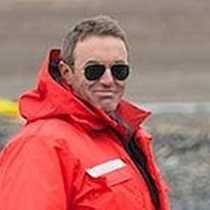Exploration and discovery; these thrills draw us to this surreal, ice-covered land. We follow in the footsteps of exceptionally brave and hardy like-minded explorers who plied these waters nearly 200 years ago, albeit without the comforts our ship affords.
Early this morning, we sailed through the narrow channel known as Neptune's Bellows into the flooded caldera of Deception Island. Landing at Whaler's Bay in windless, calm conditions, we strolled around the ruins of the whaling station and hiked up to Neptune's Window, a cleft in the cliff that affords a view across the Bransfield Strait to the Antarctic Peninsula. Deception is a quiescent volcano, and after lunch, a few brave souls ventured in for a swim in the geothermally heated waters of Pendulum Cove.
Deception Island was first discovered in 1820 by an unknown sealer. From 1819-1823, the South Shetlands teemed with small American and British sailing ships here to hunt Antarctic Fur seals. Their crews were a tough lot, exploring the edge of the world without charts, navigational equipment, or adequate clothing. Many men and vessels were lost, but fortunes were also made in this newly discovered land. Of course the boom times couldn't last, and after only three years, the Fur seals were almost completely wiped out, and the men and ships disappeared.
Late in the afternoon, stimulated by our desire for further exploration and discovery, we headed for Snow Island, another of the South Shetlands. This is a remote island that we have never visited; indeed no passenger vessel has ever called at these rugged shores. Scout parties zipped away from the mother ship, and before long a good landing beach was found. Ashore, walking among the enormous Southern Elephant seals (pictured here), one felt a connection with the sealers of the 1820's, who may indeed have been the last humans to trod this beach.
Early this morning, we sailed through the narrow channel known as Neptune's Bellows into the flooded caldera of Deception Island. Landing at Whaler's Bay in windless, calm conditions, we strolled around the ruins of the whaling station and hiked up to Neptune's Window, a cleft in the cliff that affords a view across the Bransfield Strait to the Antarctic Peninsula. Deception is a quiescent volcano, and after lunch, a few brave souls ventured in for a swim in the geothermally heated waters of Pendulum Cove.
Deception Island was first discovered in 1820 by an unknown sealer. From 1819-1823, the South Shetlands teemed with small American and British sailing ships here to hunt Antarctic Fur seals. Their crews were a tough lot, exploring the edge of the world without charts, navigational equipment, or adequate clothing. Many men and vessels were lost, but fortunes were also made in this newly discovered land. Of course the boom times couldn't last, and after only three years, the Fur seals were almost completely wiped out, and the men and ships disappeared.
Late in the afternoon, stimulated by our desire for further exploration and discovery, we headed for Snow Island, another of the South Shetlands. This is a remote island that we have never visited; indeed no passenger vessel has ever called at these rugged shores. Scout parties zipped away from the mother ship, and before long a good landing beach was found. Ashore, walking among the enormous Southern Elephant seals (pictured here), one felt a connection with the sealers of the 1820's, who may indeed have been the last humans to trod this beach.




